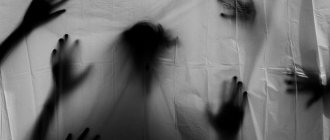Panic attack is an attack of severe anxiety, fear, panic, which is accompanied by certain vegetative (bodily) reactions.
The duration of attacks can vary from several minutes to several hours, averaging 15-30 minutes.
For an anxiety attack to be identified as a panic attack, it must have at least four of the following core symptoms:
- Rapid pulse;
- Sweating;
- Feeling short of air, shortness of breath, difficulty breathing;
- Chills, tremors, internal trembling;
- Pain or discomfort in the left side of the chest;
- Nausea;
- Dizziness, lightheadedness;
- Derealization, depersonalization;
- Fear of going crazy or doing something uncontrollable;
- Fear of death;
- Feeling of numbness or tingling in the extremities;
- Insomnia;
- Confusion of thoughts;
Other (additional) symptoms may be present:
- Abdominal pain,
- Elevated temperature
- Stool disorder
- Frequent urination,
- Feeling of a lump in the throat
- Gait disturbance
- Visual or hearing impairment
- Cramps in the arms or legs,
- Motor function disorder
- High blood pressure.
Patients often talk about the spontaneity (unprovoked) of attacks. However, during the conversation it often turns out that along with spontaneous manifestations of PA, there are also situational attacks that occur in places perceived by a person as potentially dangerous. Such places and situations include:
- Using public transport;
- Staying in a large crowd of people or, conversely, in a confined space;
- And sometimes even, simply, the need to leave your own home.
This list can go on for a long time, but we will stop here.
Free psychological help awaits you on Tik Tok. Just go to the @psy_malin and click “Ask a question” or write a personal message to psychologist Dmitry Malin.
Panic disorder
Panic attacks are a symptom of what is called panic disorder.
Panic disorder (episodic paroxysmal anxiety) is a mental disorder that is characterized by the spontaneous occurrence of panic attacks from several manifestations per year to several times a day and restless anticipation of their occurrence.
“Panic disorder” is recognized worldwide as an independent disease. It is included in the International Classification of Diseases, 10th revision (ICD-10)
Some Russian doctors use outdated terms that are not in the ICD, but they emphasize the type of disorder of the autonomic nervous system depending on the leading symptom:
- "vegetative crisis";
- “sympathoadrenal crisis”;
- "cardioneurosis";
- “VVD (vegetative-vascular dystonia) with a crisis course”;
- “NCD” (neurocirculatory dystonia)
The essence of auto-training
The founder of auto-training was Dr. I.G. Shultz. Later, after Schultz, many methods of conducting this therapy were described, including with the help of yoga and the teachings of Tibetan monks.
In 1932, Dr. Schultz, conducting hypnosis sessions with patients, noticed that some of them became much calmer and more relaxed during the procedure. Modern scientists have proven that self-hypnosis therapy for neuroses and overexcitation is a completely effective means for both treatment and prevention of such conditions.
The goal of auto-training for the patient is to reduce the memory of the disease, overcome their fears and achieve peace of mind.
Self-hypnosis has opened up a lot of opportunities for Eastern masters. With its help, they can control the work of their own body - slow down the pulse, stop and start the heart. The absolute record was set by one of the masters, who, having plugged his nostrils and ears, withdrew into himself for 30 days, while completely stopping all the vital processes of the body.
Modern man does not need such superpowers, but putting his thoughts in order, normalizing sleep and restoring the ability to enjoy life is quite possible with simple autodidactic exercises.
Causes and development of panic attacks
Panic attacks occur when anxiety levels are extremely high.
If with phobias anxiety is increased and is looking for a way to rationalize itself, turning into a specific fear, then with panic attacks the level of anxiety is even higher and it is no longer looking for a specific object to realize. Anxiety just comes out and takes a person by surprise. This can happen anywhere: in the subway, in a bank, in a store, just on the street, etc.
As a rule, a panic attack occurs when a person’s anxiety is further “stimulated.” For example, a person finds himself in a crowded place and it seems to him that for some reason he looks “different” today and that everyone is looking at him. This can create fear in him of being judged and provoke PA.
Self-esteem
An important fact is that people suffering from panic attacks generally always have low self-esteem. They are very critical of themselves. And the triggers for panic attacks are often their thoughts about how they look from the outside and what others think about them. These obsessive thoughts cause internal tension and anxiety. Fear of condemnation makes a person afraid to express himself spontaneously. He fears that someone may not like this behavior of his and cause negative emotions in this dissatisfied person, which he can somehow express.
Comfort zone and anxiety control
Very often, the comfort zone of anxious people is very narrow and cramped, and it is very easy to accidentally push them out of there. At the same time, any exit from the comfort zone causes additional anxiety and threatens the appearance of another panic attack.
With all this, being in the comfort zone, a person with this anxiety-phobic disorder does not feel completely calm. He's still worried. But being in familiar conditions, he learns not to notice his excitement.
When everything is under control, such a person has the mental resource to repress his anxiety, not to think about what causes it, being in the illusion of comfort. He fills his head with unimportant considerations that have no effect on anything.
But as soon as he leaves the usual conditions of existence, his neuropsychic energy becomes aimed at adapting to a changing environment and there is no resource left for restraining anxiety, which leads to its release in the form of panic attacks.
Upbringing
If during psychotherapy we dive into the deep layers of the psyche and look for the origins of a given mental disorder, then we will always come to childhood and the relationship that this person had with his parents.
Parents of a person with panic disorder constantly emphasized his inferiority in one way or another:
- They might not believe that he would succeed;
- They often shamed him, making him feel unworthy of something or guilty of something;
- They were constantly saying that someone was better than him;
- In general, by all means they taught him to depend on someone else’s assessment so that he would meet some non-existent standards.
The fact is that a person with PA does not allow himself to criticize the upbringing that his parents gave him and idealizes them, forgetting that they are ordinary people who, like everyone else, tend to make mistakes. This approach to one’s personality and the personality of one’s parents becomes one of the reasons for the occurrence of PA.
Agoraphobia. Panic anchors.
A special type of phobia can also be formed based on panic attacks.
If with the usual version of the formation of phobias some kind of logic of events is needed, then for the formation of phobias under the influence of panic attacks it is not needed. Since a panic attack can happen anywhere and anytime, a phobia can form for anything. And such a phobia will not be one, but there will be many of them, since each place and circumstances in which a panic attack occurred will become an anchor reminding a person of the incident in which he fell into a panic. And during the course of the illness, such anchors will accumulate more and more, due to the fact that a panic attack happens each time in new places and in new conditions. Thus, panic attacks expand their domain and over time a person begins to be afraid to leave the house, since a phobic state arises in him almost everywhere.
The result is agoraphobia
- fear of crowded places.
Cold and hot shower
Very simple and very effective. First, short-term exposure to cold stimulates the release of hormones that improve our mood and make us a little happier. Secondly, this method can be used both systematically to reduce the overall level of anxiety, and as an “emergency remedy” at the moment the first symptoms of a panic attack appear.
How to do it: you need to pour yourself over your head. First, turn on the warm water, then switch to cold for a few seconds, then back to warm. The water should be almost icy, not cool. In this case, the body’s defenses are activated, and it is almost impossible to catch a cold. Before carrying out the procedure, you should consult your doctor.
Treatment
Increased self-esteem
One of the areas of treatment for panic attacks is to work on increasing self-esteem and self-confidence. And also on the ability to be critical of the personality of your parents. The ability to criticize the upbringing that was given to him by his parents will allow a person to move forward, working on his personal characteristics and developing his own individuality, rather than freezing in place, afraid to change what the adults who are significant to him have created.
In the process of psychotherapy, a person goes through the following stages:
- Understanding that parents are not perfect, since they are ordinary people;
- Protest against the methods of education that parents used and against the parents themselves;
- Separation - mental separation from parents;
- The beginning of the formation of one's own personality;
- Acceptance and gratitude to parents for doing everything they could and as best they could to raise their child.
- Accepting yourself as you are and starting to build your life in accordance with your own preferences.
Disclaimer
It is worth noting that all the procedures described in this section are best carried out under the supervision of a psychotherapist or psychologist. Or at least visit him periodically and tell him about the work done in order to receive the necessary recommendations and make adjustments to your wellness actions.
Self-treatment
Simultaneously with working on self-esteem, it is necessary to carry out procedures that help reduce anxiety.
Helps reduce anxiety:
- Breathing exercises;
- Sports activities;
- Autogenic training;
- Relaxation exercises.
Medicines
Also, if a psychiatrist or neurologist prescribes medications, then you should not neglect them, just as you should not get carried away.
Medicines should be treated as an auxiliary tool that facilitates psychotherapy and the dosage of which should be constantly reduced as psychotherapeutic treatment progresses.
Psychotherapy
Psychotherapeutic treatment can be carried out in various directions:
- Cognitive behavioral therapy. It will help you develop the habit of not being afraid of panic attacks.
- Body-oriented therapy. Will teach you to understand the body signals that precede panic attacks, as well as manage bodily reactions to reduce symptoms.
- Hypnotherapy. It will help create new internal attitudes that promote mental immunity, helping to predict and prevent panic attacks.
In addition to all of the above, a psychotherapist will help you understand the causes of PA. During psychotherapeutic sessions, it will become clear what underlies this disorder and what events or series of events led to it.
Complex treatment
In order for the treatment of panic attacks to be successful, a certain number of vectors must converge:
- A doctor prescribing medications must respect psychotherapeutic methods of treatment and understand that medications do not fully treat a mental disorder, but only relieve certain bodily symptoms and adjust the chemical and hormonal background of the body. As soon as a person stops taking them, his body stops producing the chemical elements necessary to maintain health. Therefore, in the long term, medications lead to addiction.
- The psychotherapist should also not sabotage drug treatment, but should enter into collaboration with the doctor to discuss the results of drug-psychotherapeutic treatment, as well as determine and adjust the dosage of medications.
- The third condition is the cooperation of the patient himself with the specialists treating him. He should try to be honest with them and follow all their instructions. In other words, the patient must feel responsible for what happens to him and not shift it to the people treating him.
Treatment results
If client-doctor-psychotherapist cooperation is established, then a decrease in the number of panic attacks will gradually be observed, as a result of which they will stop completely.
As treatment progresses, the dosage of medications should be reduced until they are completely discontinued. All this should happen against the background of psychotherapeutic treatment.
As general anxiety decreases, both phobias and panic attacks will go away, that is, complete physical and mental recovery will occur.
Author: Dmitry Malin - clinical psychologist
Benefits of PA psychotherapy
When turning to a psychotherapist in specialized clinics for the treatment of panic attacks, a person has the opportunity to significantly reduce the time of treatment for the disorder. The work follows specialized protocols that take into account all factors in the occurrence and maintenance of the disorder.
Who is psychotherapy suitable for?
Psychotherapy for panic disorder has no special contraindications . The restrictions relate to general contraindications in psychotherapy, for example, cognitive deficits in humans.
Therapy for panic disorder can be carried out without loss of effectiveness online via Skype. This is convenient for remote areas of Russia, where there are no specialists who successfully use methods of treating panic attacks and panic disorder.
How panic attacks are treated by a psychotherapist
The treatment protocol for panic disorder consists of:
- identifying panic triggers;
- psychoeducation of the patient - an explanation of the ongoing processes from a scientific point of view;
- identifying misconceptions about panic;
- withdrawal of protective behavior;
- exposition.
Exposure is the presentation of frightening situations, the experience of which gives the person a new experience that a panic attack is experienced. It helps reduce panic attacks during neurosis. This is a necessary element of therapy, which, through the experience of fear, under the supervision of a specialist, leads to a good result and recovery.
Preparation for auto-training
Choosing the timing of training is an important aspect of auto-training. If you know your body well enough, then choose a time when it is most relaxed: immediately after sleep or in the evening after work. Comfortable selection of a time interval is the first step to success in treatment.
If it is difficult for you to immediately understand when it is more convenient to practice, then you can experiment. Try different options and choose the one that suits you best.
Organize your daily routine so that your training time does not change. The regularity of auto-training will allow the body to develop a habit over time, then each time it will independently relax by a certain time, so that the effect of therapy is maximum.
The patient's positive attitude and faith in the technique are also keys to healing. At this stage, the patient’s main task is to set a goal and go towards it. You should not miss a single workout - only systematically conducted sessions can help you achieve maximum results in the shortest possible time. It would be useful to study specialized literature.
The patient’s rethinking of his life and his priorities will be of great help in treatment. First of all, you should understand yourself, understand why you live. Surely something will have to change. But these changes will only benefit you.











